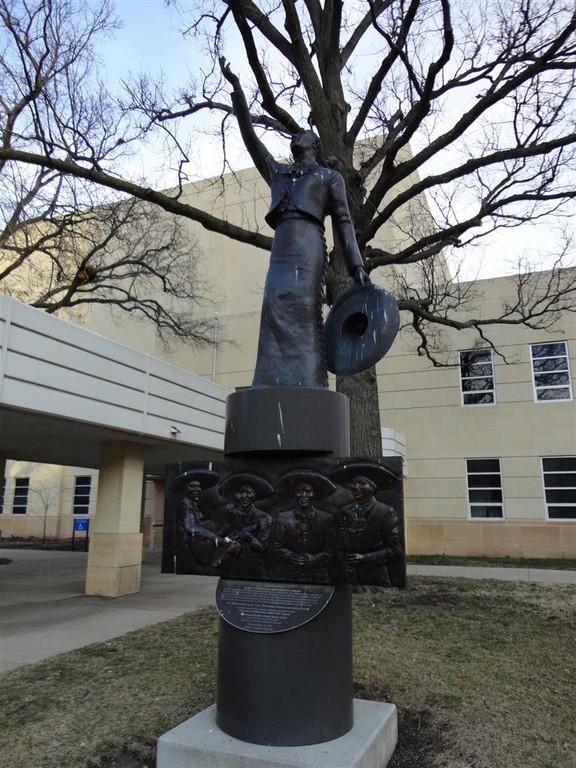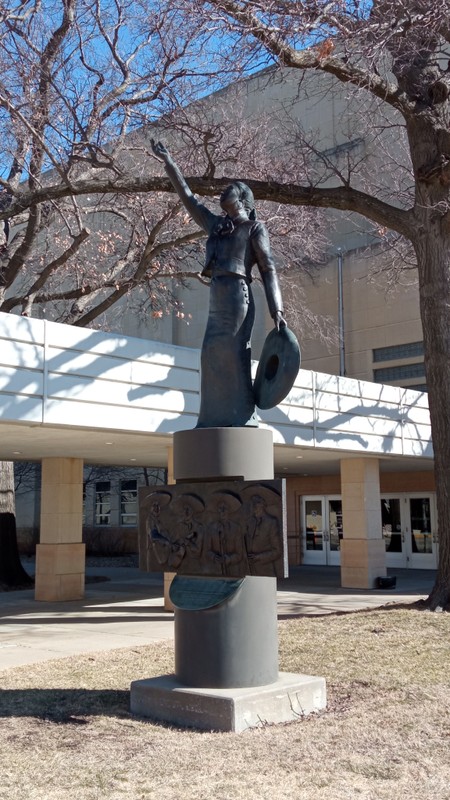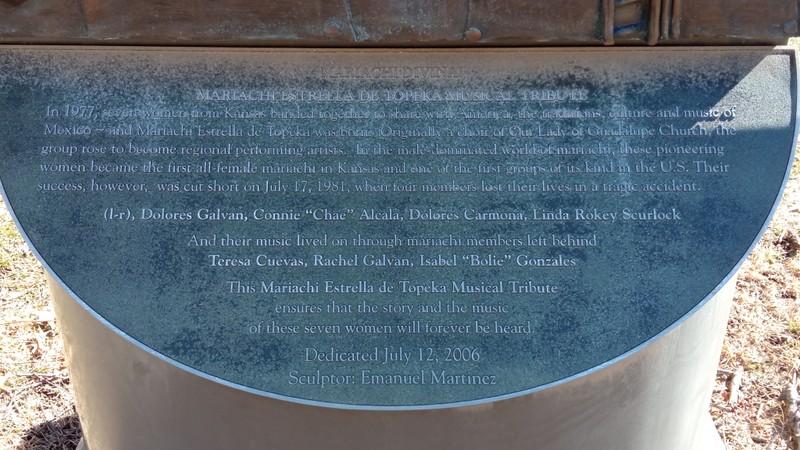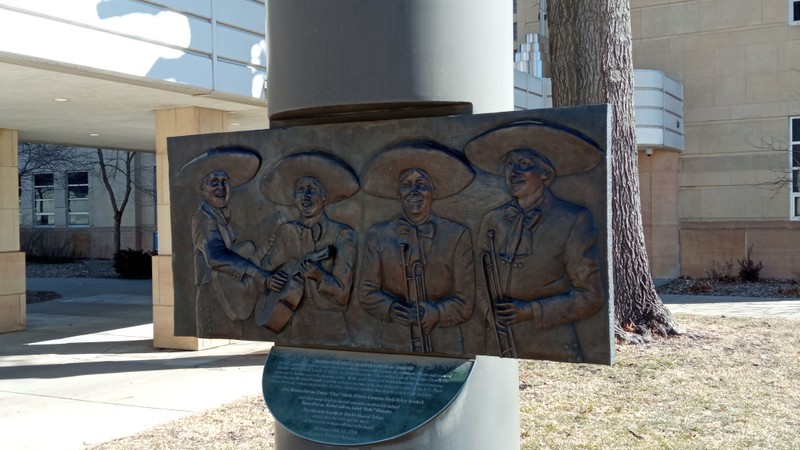Mariachi Divina! - Mariachi Estrella de Topeka Musical Tribute
Introduction
Text-to-speech Audio
Topeka has long been renowned for its contributions to music in every genre. However, throughout the history of the United States as well as Kansas, few musical groups have been as influential as Mariachi Estrella de Topeka. Consisting of seven women, Mariachi Estrella de Topeka rose to Kansas statewide prominence throughout the 1970s and especially in 1980 and 1981. More importantly, this group was the first all-female mariachi group (a musical genre typically dominated by males) in not only Kansas, but quite possibly the United States. Just as the group was taking off, they met a horrible tragedy in 1981 when the walkways at the Hyatt Regency in Kansas City collapsed, killing four members and 110 other people. An eight-foot bronze statue of a female mariachi player rests in front of the Topeka Performing Arts Center, memorializing the musical pioneers. This story captures the importance of preserving Kansas’s Mexican American communities and culture, which are a crucial part of democracy in the United States.
Images
The Mariachi Divina! - Mariachi Estrella de Topeka Musical Tribute sculpture

Members of Mariachi Estrella de Topeka included (from left) Dolores Carmona, Linda Scurlock, Dolores Galvan, Connie Alcala and Rachel Galvan Sangalang.

Aftermath of the walkway collapse

Bronze statue of Teresa Cuevas outside of the Topeka Performing Arts Center.

Description of the Mariachi Divina statue and a brief account of the group’s story.

Bronze relief of the four Mariachi Estrella members lost in the Hyatt tragedy: Dolores Galvan, Connie Alcala, Dolores Carmona, and Linda Rokey Scurlock.

Backstory and Context
Text-to-speech Audio
History of Mariachi Estrella de Topeka
Mariachi music is a folk music that comes from Mexico, and upon hearing its trumpets, violins, and guitars, it is instantly recognizable. This genre dates back to before the arrival of the Spanish, though the modern incarnation of mariachi is associated with the early 20th century.
It was first introduced in Mexico City in 1905, and in the 1920s, the music was broadcast throughout the country through several radio networks. The first mariachi groups in the United States came from California in the late 1950s and 1960s. Up until the appearance of Mariachi Estrella de Topeka, the music genre was heavily related to machismo culture, particularly in terms of drinking tequila and womanizing.1
In the later 1970s in Topeka, at the request of a Guatemalan priest who was asking for livelier music in the church choir, seven women joined together to form the first all-female mariachi group, “Mariachi Estrella de Topeka”. These women brought the typical mariachi instruments from Mexico to Topeka and began playing at Topeka’s Our Lady of Guadalupe Church.
The group consisted of Teresa Cuevas, Connie Alcala, Isabel Gonzalez, Rachel Galvan Sangalang, Dolores Galvan, Dolores Carmona and Linda Scurlock, and prior to playing at the church, they had little mariachi experience. They learned quickly, however, as they practiced the traditional mariachi instruments in a self-taught atmosphere.
After attending a mariachi conference in San Antonio in 1980, the women had caught mariachi fever and cemented their goal to play mariachi on a broader scale. The self-taught musicians returned to Topeka after the conference, practiced diligently, and even had women’s mariachi regalia tailored for them. Soon enough, the seven women were playing across the Kansas State and garnering widespread popularity.2
The Walkway Collapse at the Hyatt Regency in Kansas City
Mariachi Estrella de Topeka had a gig to play at the Hyatt Regency in Kansas City on July 17th, 1981. Unfortunately, they never played due to one of the worst structural disasters in United States history (it was unsurpassed until the collapse of the World Trade Center in 2001).
That evening, around 1,600 people stood in the atrium as well as on the fourth-floor and second-floor walkways watching a tea dance. The members of Mariachi Estrella de Topeka were about to perform for the Fuller Brush company, and with their outfits on, they were traversing the skywalk when the walkway collapsed.
The fourth-floor walkway (the skywalk) crashed into the second-floor walkway, and then both walkways fell into the lobby below. In total, 114 people died and 219 were injured. Four of these deaths included Linda Scurlock, Dolores Galvan, Connie Alcala and Dolores Carmona. Only Rachel Galvan Sangalang and Teresa Cuevas survived the fall. The seventh member, Isabel "Bolie" Gonzales, was not at the Hyatt Regency that fateful day.
This marked the virtual end of the first all-female mariachi group, but they immediately became legendary, almost mythic figures in Kansas’s Latino community. In fact, they have served as an inspiration to thousands of girls in the state, showing them that when you have a passion for something, you can go out and do it.
According to Cuevas, “We kept at it, the girls and me. We had a lot of fun when we played. I think when you’re doing something that you’re doing yourself, you feel very fortunate. It gives me a lot of peace. It has been a very good thing in my life.”3
Memorial Unveiling
In 2006, the one-of-a-kind monument was unveiled at the Topeka Performing Arts Center, memorializing and paying tribute to the mariachi group. The eight-foot tall memorial standing on a two-foot pedestal was designed by the Denver-born sculptor Emmanuel Martinez.
The statue features a woman in a traditional mariachi costume, and she holds her right arm in the sky while holding a sombrero against her leg. The base relief of the statue features the four women who died in 1981.4
Inscription on the Memorial
In 1977, seven women from Kansas banded together to share with America, the traditions, culture and music of Mexico - and Mariachi Estrella de Topeka was born. Originally a choir of Our Lady of Guadalupe Church, the group rose to become regional performing artists. In the male-dominated world of mariachi, these pioneering women became the first all-female mariachi in Kansas and one of the first groups of its kind in the U.S. Their success, however, was cut short on July 17, 1981, when four members lost their lives in a tragic accident.
[Relief](l-r), Dolores Galvan, Connie "Chae" Alcala, Dolores Carmona, Linda Rokey Scurlock
And their music lived on through mariachi members left behind
Teresa Cuevas, Rachel Galvan, Isabel "Bolie" Gonzales
This Mariachi Estrella de Topeka Musical Tribute ensures that the story and the music of these seven women will forever be heard.
Dedicated July 12, 2006
Sculptor: Emanuel Martinez5
Cite This Entry
Newcomer, Daniel et. al. "Mariachi Divina! - Mariachi Estrella de Topeka Musical Tribute." Clio: Your Guide to History. February 28, 2023. Accessed March 30, 2025. https://theclio.com/tour/596/5/reverse
Sources
1.) "Mariachi History and Tradition." Mariachi-Plaza.com. Accessed July 11, 2015. http://www.mariachi-plaza.com/mariachi-history.htm
2.) Blankenship, Bill. "'Viva la musica!' -- Statue honors spirit of Mariachi Estrella." The Capital Journal. Accessed July 11, 2015. http://cjonline.com/indepth/fiesta/stories/072101_fiesta.shtml
3.) Laessig, Gavon. "Mariachi Divina: New film celebrates legacy of Kansas mariachi legends, Mariachi Estrella de Topeka." Lawrence-Journal World. February 20, 2010. http://www2.ljworld.com/news/2010/feb/20/mariachi-divina-new-film-celebrates-legacy-kansas-/.
4.) Blankenship, Bill. "'Viva la musica!' -- Statue honors spirit of Mariachi Estrella."
5.) "Mariachi Divina! - Mariachi Estrella de Topeka Musical Tribute." The Historical Marker Database. Accessed July 11, 2015. http://www.hmdb.org//marker.asp?marker=48492&Result=1.
Photo by Kit Auner.

